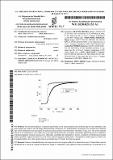Por favor, use este identificador para citar o enlazar a este item:
http://hdl.handle.net/10261/242847COMPARTIR / EXPORTAR:
 SHARE
BASE SHARE
BASE
|
|
| Visualizar otros formatos: MARC | Dublin Core | RDF | ORE | MODS | METS | DIDL | DATACITE | |

| Campo DC | Valor | Lengua/Idioma |
|---|---|---|
| dc.contributor.author | Blanco Montes, Álvaro | es_ES |
| dc.contributor.author | Fernández Morales, Miguel Ángel | es_ES |
| dc.contributor.author | Gallego-Gómez, Francisco | es_ES |
| dc.contributor.author | López, Cefe | es_ES |
| dc.date.accessioned | 2021-06-08T08:00:20Z | - |
| dc.date.available | 2021-06-08T08:00:20Z | - |
| dc.date.issued | 2020-01-30 | - |
| dc.identifier.citation | WO2020021153 A1 | es_ES |
| dc.identifier.uri | http://hdl.handle.net/10261/242847 | - |
| dc.description.abstract | Sensor de humedad basado en la respuesta óptica de un ópalo artificial a la adsorción de agua. El diseño básico precisa únicamente de la lectura de la banda de difracción Bragg (su intensidad a una longitud de onda preestablecida o su posición) de un ópalo artificial cuya fabricación no necesita de ningún post-procesamiento (funcionalización de superficies, infiltración, curado, etc.). El sensorresponde directamente a la adsorción de moléculas de agua en el ópalo y no requiere, por tanto, de fenómenos intermedios (tales como imbibición, dilatación por hidratación, reacciones químicas, etc.). Opcionalmente, el control de la hidrofilicidad, porosidad, periodicidad o fracción de llenado del ópalo permite ajustar la sensibilidad del sensor y/o región de lecturadel pico Bragg. El elemento responsivo (el ópalo) es inalámbrico, miniaturizable a pocas micras cúbicas y su tiempo de respuesta es típicamente inferior a un segundo. [ES] | es_ES |
| dc.description.abstract | The invention relates to a moisture sensor based on the optical response of an artificial opal to water adsorption. The basic design only needs to read the Bragg diffraction band (its intensity at a predetermined wavelength or its position) of an artificial opal whose manufacture does not require any post-processing (surface functionalisation, infiltration, curing, etc.). The sensor responds directly to the adsorption of water molecules on the opal and therefore does not require intermediate phenomena (such as imbibition, hydration expansion, chemical reactions, etc.). Optionally, controlling the hydrophilicity, porosity, periodicity or fill fraction of the opal makes it possible to adjust the sensitivity of the sensor and/or Bragg peak reading frame. The responsive element (opal) is wireless, can be miniaturised to a few cubic microns and has a response time of typically less than one second. [EN] | es_ES |
| dc.language.iso | spa | es_ES |
| dc.rights | openAccess | es_ES |
| dc.title | Moisture sensor | es_ES |
| dc.title.alternative | Sensor de humedad | es_ES |
| dc.type | solicitud de patente | es_ES |
| dc.description.peerreviewed | Peer reviewed | es_ES |
| dc.description.assignee | Consejo Superior de Investigaciones científiicas (España) | es_ES |
| dc.date.priority | 2019-07-26 | - |
| dc.identifier.citationapplication | PCT/ES2019/070531 | es_ES |
| dc.relation.patentfamily | ES2738913 A1 (2020-01-27) | es_ES |
| dc.description.kind | A1 Solicitud de patente con informe sobre el estado de la técnica | es_ES |
| dc.relation.csic | Sí | es_ES |
| oprm.item.hasRevision | no ko 0 false | * |
| item.openairetype | solicitud de patente | - |
| item.cerifentitytype | Publications | - |
| item.grantfulltext | open | - |
| item.fulltext | With Fulltext | - |
| item.openairecristype | http://purl.org/coar/resource_type/c_18cf | - |
| item.languageiso639-1 | es | - |
| Aparece en las colecciones: | (ICMM) Patentes | |
Ficheros en este ítem:
| Fichero | Descripción | Tamaño | Formato | |
|---|---|---|---|---|
| WO2020021153A1.pdf | 1,21 MB | Adobe PDF |  Visualizar/Abrir |
CORE Recommender
NOTA: Los ítems de Digital.CSIC están protegidos por copyright, con todos los derechos reservados, a menos que se indique lo contrario.
